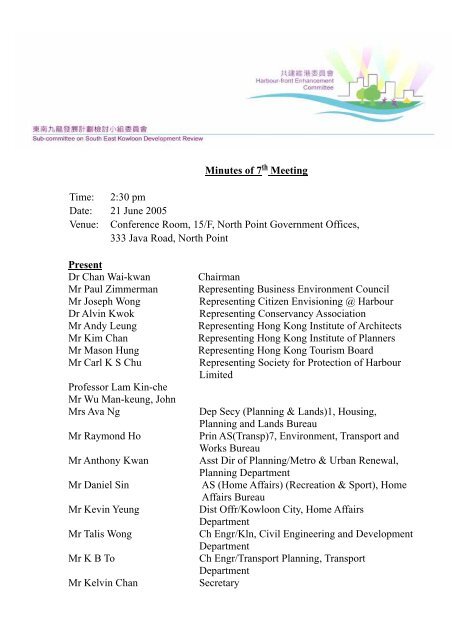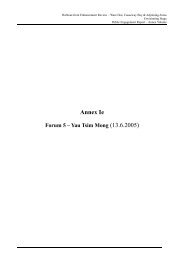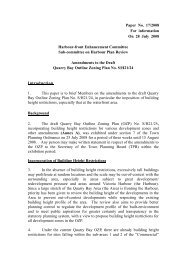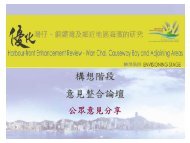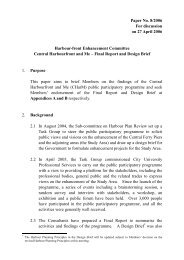PDF Format - Our Harbour Front
PDF Format - Our Harbour Front
PDF Format - Our Harbour Front
You also want an ePaper? Increase the reach of your titles
YUMPU automatically turns print PDFs into web optimized ePapers that Google loves.
Minutes of 7 th MeetingTime: 2:30 pmDate: 21 June 2005Venue: Conference Room, 15/F, North Point Government Offices,333 Java Road, North PointPresentDr Chan Wai-kwanMr Paul ZimmermanMr Joseph WongDr Alvin KwokMr Andy LeungMr Kim ChanMr Mason HungMr Carl K S ChuProfessor Lam Kin-cheMr Wu Man-keung, JohnMrs Ava NgMr Raymond HoMr Anthony KwanMr Daniel SinMr Kevin YeungMr Talis WongMr K B ToMr Kelvin ChanChairmanRepresenting Business Environment CouncilRepresenting Citizen Envisioning @ <strong>Harbour</strong>Representing Conservancy AssociationRepresenting Hong Kong Institute of ArchitectsRepresenting Hong Kong Institute of PlannersRepresenting Hong Kong Tourism BoardRepresenting Society for Protection of <strong>Harbour</strong>LimitedDep Secy (Planning & Lands)1, Housing,Planning and Lands BureauPrin AS(Transp)7, Environment, Transport andWorks BureauAsst Dir of Planning/Metro & Urban Renewal,Planning DepartmentAS (Home Affairs) (Recreation & Sport), HomeAffairs BureauDist Offr/Kowloon City, Home AffairsDepartmentCh Engr/Kln, Civil Engineering and DevelopmentDepartmentCh Engr/Transport Planning, TransportDepartmentSecretary
- 2 -In AttendanceMs Christine ChowMr Raymond LeePrin AS(Planning & Lands)2, Housing, Planningand Lands BureauDist Planning Offr/Kln, Planning DepartmentConsultantsMs Iris Tam] City Planning – Maunsell Joint VentureMr Derek Sun ]Mr Igor Ho ]Absent with ApologiesProfessor JIM Chi-yungMr Charles Nicholas BrookeMs Lee Wai-king, StarryOpening RemarksThe Chairman welcomed Mrs Ava Ng, Dep Secy (Planning &Lands)1, Housing, Planning and Lands Bureau attending the meetingfor the first time.Item 1Confirmation of Minutes of 6 th MeetingAction1.1 The Chairman said that the draft minutes of the 6 th meetingwere circulated to Members for comments on 31.5.2005. Asthere were no further comments, the meeting confirmed theminutes.Item 2Matters Arising2.1 The Chairman noted that most of the matters arising from the6 th meeting had been included in Agenda Items No. 3 and 4 inthis meeting.2.2 Para 3.9: In response to the Chairman, Mr Talis Wong saidthat the suspected oil spillage did not come from the barges ofCivil Engineering and Development Department’s (CEDD’s)contractors. The Secretary said that the District LandsOfficer/Kowloon East (DLO/KE) had undertaken site
- 3 -inspections recently but did not record oil spillage in the area.They had reminded the tenants of the Short Term Tenancies onthe Government land along the waterfront area to keep theforeshore area clean. Both Marine Department andEnvironmental Protection Department (EPD) were informed ofthe issue.2.3 Para 3.20: The Chairman noted that the temporarystockpiling at the runway area would cease operation by the endof 2006. He questioned whether enhancement works could becarried out immediately afterwards. Mr Talis Wong said thatit was an on-going effort to relocate the stockpiled materials toother sites and the volume of stockpiles had already beenreduced. He agreed that concerned departments should getprepared in advance so that upon clearance of the site, the areacould be released for other beneficial uses to enable the publicto have easy access to the waterfront. In this regard, CEDDwould continue to liase with LandsD to explore futuretemporary uses for the area and report to the Committee in duecourse. The Chairman said that the subject on temporaryuses in Kai Tak should be monitored by the concerneddepartment and reported to this Committee where appropriate.All to note2.4 In response to Mr Paul Zimmerman’s questions on fundingand programming arrangements for the enhancement work inthe waterfront area, Mrs Ava Ng said that the HEC haddiscussed this issue. They would work with the concerneddepartments on this matter. Mr Paul Zimmerman said thatthe concerned bureaux/departments should expedite theiractions as the issue had been raised in the HEC for some timesalready. This concern was also applicable to the early actionto clean up the Kai Tak Approach Channel.Briefing to Town Planning Board on Kai Tak Planning Review2.5 In view of the concerns of Members on the recent reports in thenewspapers regarding TPB’s comments on the Kai TakPlanning Review, the Chairman proposed and Members agreedto advance the discussion of this issue under Matters Arising.2.6 The Chairman said that as part of the public participationprogramme of the Kai Tak Planning Review (the Study),Planning Department (PlanD) briefed the statutory and advisory
- 4 -committees, e.g. the District Councils (DCs) and LegCo Panel,etc. on a regular basis. On 17.6.2005, the Town PlanningBoard (TPB) was briefed on the progress of the Study. Theoccasion was widely covered by the mass media as this was thefirst open meeting of TPB. Since the briefing was related tothe Study and open to the public, some Members opined thatthey should be informed of the event, with the option toparticipate, where appropriate.2.7 Mr Raymond Lee said that apart from the briefings undertakenunder the Stage 1 Public Participation, they would brief thesebodies and other interested parties if and when necessary todiscuss progress of the Study. He said that in view ofMembers’ interest, PlanD would inform Members of theseevents in the future.PlanD2.8 Mr Raymond Lee said that the recent TPB briefing mainlycovered the study progress, activities undertaken in the Stage 1Public Participation and key comments received. The TPBmembers’ main concerns were on the technical issues, publicopinions on the proposed uses, population projection and slowprogress of the development of Kai Tak site. They urged theGovernment departments to expedite the study process.2.9 Referring to a newspaper report of 18.6.2005, Dr Alvin Kwoksaid that Mrs Rita Lau, Permanent Secretary for Housing,Planning and Lands (PSPL), as Chairperson of the TPB, wasquoted to have said during the briefing session, that “publicconsultation process could not go on forever” and “hoped thatpublic consensus could be concluded in the future submissionto the TPB”. Mr Raymond Lee said that the TPB membersnoted the comments received in the Stage 1 PublicParticipation, some of which might be conflicting and stressedthe need to strike a balance. He said that Mrs Lau wasconcluding the discussions of the meeting and had highlightedthe importance of a proper balance between public participationand early development of the Kai Tak site.2.10 Mr Paul Zimmerman asked whether Mrs Lau’s concludingremarks represented the Chairperson’s summary of the views ofthe TPB members or whether it was an Administration’sposition. The Chairman remarked that this was a questionfor the TPB and the Administration, it was not one which couldbe answered in this meeting. However, he considered it a fair
- 6 -their consultation exercise, where appropriate.2.16 Mrs Ava Ng said that the HPLB fully supported the work of theHEC and their advice on the public engagement activities tohelp building public consensus on various planning anddevelopment issues. She pointed out that the main purpose toset up the HEC was to strengthen the communication with thecommunity and general public. Mrs Ava Ng urged Membersnot to perceive negatively to the reports published innewspapers recently. She continued that the HPLB treasuredthe efforts of the HEC in strengthening the public engagementactivities and opined that TPB members’ concern was onwhether Government departments could expedite their workprocess to enable early development in the Kai Tak area.2.17 Mr Anthony Kwan said that PlanD also fully supported publicparticipation in the planning process. He explained that theTPB’s main concern was on the work of the Governmentdepartments. He said that continual public participation couldfocus discussion on key issues at the early stage and avoidabortive work later in the implementation phase.2.18 Mr Andy Leung said that PlanD should address this concern ofTPB and highlight the programming implications to the HECmembers, where necessary, in future discussions.2.19 Dr Alvin Kwok opined that Mrs Lau, as Chairperson of theTPB, member of the HEC and also PSPL, should be in a goodposition to bridge the interests of the three bodies and enhanceliaison with the TPB. However, the newspaper reports gavethe impression that the public participation process wasaffecting the development process of Kai Tak.2.20 Mr Paul Zimmerman expressed regret that the PSPL had nottaken the opportunity to define the relationship between theHEC and TPB and questioned whether Members’ efforts hadbeen spent for the right reasons. He said that the HEC, in theirearlier discussions had established public participation in theplanning process as an on-going process. In light of the recentconcern to speed up the planning process, it warranteddiscussion on the perceived obstacles which delayed the processand actions required to expedite it.
- 7 -2.21 In response, Mrs Ava Ng said that the TPB, as a statutory body,would also take into account public comments in their work.HEC’s initiative on the public participation process wouldcontribute to TPB’s deliberation on the OZPs for the Kai Takarea. Since planning was an on-going exercise that it wouldrequire continuous effort to gather public feedback to therelevant proposals, the HEC was invited to advise and assist inthis process. In response to the Chairman’s question, MrsAva Ng confirmed that HPLB did not perceive publicparticipation as a waste of time and there was no question thatthe HPLB would want to terminate the on-going consultationexercise.2.22 The Chairman suggested that the HEC should communicatemore with the TPB vis-à-vis the concept of public participation.He said that Members expected Mrs Lau, as the Chairperson ofTPB, PSPL and member of the HEC, to defend the publicparticipation process, as and when necessary. In concluding,the Chairman said that given the impression that the TPB castdoubt on the on-going public participation process, he remindedMembers to study the minutes of the TPB meeting and topursue this issue further, if necessary. As raised in the TPBbriefing session, the HEC Sub-committee would invite the TPBmembers to participate in future public engagement activities toenhance communication.[Post-meeting Notes: Extract of Confirmed TPB minutes ofmeeting of 17.6.2005 is at Annex I]Item 3Report on Collaborators Meeting[SEKD SC Paper No. 5/05]3.1 At the Chairman’s invitation, Mr Anthony Kwan said that atthe last Sub-committee meeting, Members decided to convene aCollaborators Meeting (CM) to discuss the approach in thepreparation of the Outline Concept Plan (OCP) for Stage 2Public Participation. The main purpose of the CM was todiscuss the technical issues involved in preparing the options ofOCP and to gather suggestions for Stage 2 Public Participation.The meeting was held on 4.6.2005 and had covered technicalissues like Kai Tak Approach Channel (KTAC), Central
- 8 -Kowloon Route (CKR) and Road T2, Cruise Terminal,Multi-purpose Stadium, also integration between Kai Tak andnearby areas in the preparation of OCP.3.2 In presenting the draft report on the CM, Ms Iris Tam said thata number of District Councillors had also attended the CM todiscuss the local concerns on the future development of theareas near their own districts. She said that the comments raisedin the CM would be considered further and the OCPs would beprepared as soon as possible, which would be supported byjustifications and preliminary technical assessments. She thenhighlighted the following key issues that were identified in theCM:(a) Identification of beneficial uses for KTAC, accessibilityissues, mitigation measures, cost evaluation of options andtime table of implementation if there would be noreclamation, and the various cleaning options for KTAC.(b) Transportation - call for innovative approach to the design ofinterchanges for CKR/Road T2/WCR at Kowloon Bay andCha Kwo Ling to avoid segregation; also called forintegrated land use, transport and environment approach toavoid the proposed road system pre-empting thepeople-oriented living environment.(c) Locating cruise terminal and multi-purpose stadium in KaiTak were still areas of concern. Tourism Commission andHome Affairs Bureau should address these on-goingconcerns.(d) Cruise Terminal - general concern on the land use, transportand environmental impacts of this facility at the prominentwaterfront of Kai Tak.(e) Multi-purpose Stadium - whether the proposed sportsfacilities were well justified, in terms of their scale,utilisation and financial viability. Also general concern onland-take, sports policy, environmental and traffic impact ofthe facility were raised.(f) OCPs - there were insufficient points of difference in the 3preliminary options. As presented, the public would not begiven a relevant choice. The constraints imposed by theShatin to Central Link Depot needed to be addressed. Lackof waterfront activities and thus future recreation activitiesin the adjacent water bodies would be hindered. Whether
- 9 -the proposals/ideas received previously had beenincorporated/filtered out; and(g) Sustainability - whether the proposed OCPs could besustained from the economic, social and environmentalperspectives, in view of the high cost for provision ofextensive sub-merged CKR/Road T2, the mitigationmeasures for KTAC, etc.3.3 Ms Iris Tam added that the initial concepts presented in theCM were being revised to take into account the findings of thepreliminary technical assessments, in particular, the waterquality assessment.3.4 The Chairman said that Annex 2 of the Report on CM hadincluded responses to queries raised by Members after the CM.He reminded Members that it was the job of PlanD and theconsultants to prepare the OCP and the purpose of the meetingwas therefore not to come up with the best development optionbut bring out the major issues thus allowing the public to haveclearer information on the development options that would bemade available in Stage 2 Public Participation.3.5 In response to Dr Alvin Kwok’s question on the discussion ofhousing provision at the CM, Ms Iris Tam said that among the3 preliminary concepts presented at the meeting, one concepthad a slightly greater housing component and the CM hadstressed the need to balance social, environmental andeconomic considerations.3.6 In response to Professor K C Lam’s question on theexpectations for a park in Kai Tak, Ms Iris Tam said thatamong the comments raised some people felt that there shouldbe a central park, others felt that it could be provided as anetwork of parks. She said that the objective was to achieve atleast 10-20 hectares of park area even though it might not be inthe form of a single major Metro Park.3.7 In response to another question of Professor KC Lam, MrRaymond Lee said that during the Stage 1 Public Participation,there were a lot of discussions on the KTAC, including the ideato use the water body for water recreation uses. Sincepollution was the main problem of the KTAC, relevanttechnical assessments had been advanced, so that there wouldbe technical information to assist the discussion on utilizing thewater body for appropriate uses. The Consultants were
- 10 -working with the concerned departments to identify feasiblemethod to enhance the water quality of the KTAC. Ms IrisTam supplemented that the results of the assessments indicatedthat it would be difficult to have contact or secondary contactwater-based activities in KTAC.3.8 In response to Mr Kim Chan’s concern on how the harbourplanning principles would be applied in the Study, Ms Iris Tamsaid that they were taken into account in formulating theplanning principles for Kai Tak and the options of OCP. Someof the principles, including sustainability and publicinvolvement, would be adopted throughout the study process.3.9 Mr Paul Zimmerman said that the Consultants should addressthe provision of land-water interface facilities both on and offthe water to support the evolving harbour uses. In response,Ms Iris Tam said that the water quality in KTAC and KowloonBay was very problematic. Technical assessments were beingundertaken to assess whether the relevant water bodies wouldbe suitable for water-based activities. Corresponding landuses and facilities could then be planned for on the landside.Even siting of the typhoon shelter might be affected by thewater circulation in the area.3.10 On this point, Mr Paul Zimmerman asked whether theassessment of water quality would be a sequential activity indetermining an appropriate land use and whether the existingrunway could be cut through as soon as possible to startflushing the nullah. In response, Ms Iris Tam said that undernormal circumstances, beneficial land uses could be identifiedas basis to assess the requirements on water qualityimprovement. However, in this case, it was different as thewater quality problem was serious and more time was needed toundertake the relevant technical assessments. Mr RaymondLee said that the Kai Tak Approach Channel now posed majorenvironmental problems. Without the reclamation, it wouldrequire in-depth investigations to identify sustainable mitigationmeasures. The concerned departments and the Consultantswere working closely on this issue.3.11 Mr Paul Zimmerman puzzled on why marine use waspossible on one side of the harbour but not on the Kai Tak side.Without a comprehensive harbour plan as requested by theBusiness Environment Council (BEC), there was a lack of an
- 11 -overall planning context to consider allocation of keydevelopments in Kai Tak. This issue needed to be addressedto secure general support to the study proposals.3.12 The Chairman pointed out a case in point was that in Stage 1Public Participation, the proposed civil airfield was notaccepted as one of the land uses for Kai Tak. The proponentwas, however, not deterred and submitted a modified scheme toseek support to the proposal. The Chairman said that thecurrent mode of public participation was to encourage thepublic to advance the level of their views, ideas andjustifications to support their proposal as the study was makingprogress. The BEC should submit more information, betterproposal and more justifications to advance their arguments.3.13 Mr Joseph Wong commented that the CM was aimed todiscuss concerns shared by the public. However thesuggestions raised in the Stage 1 Public Participation such aswater sports/recreational uses were not raised, whereas the issueof cruise terminal and multi-purpose stadium were discussedmany times. He pointed out that it warranted a propermechanism to collate and analyse public comments. MrRaymond Lee said that the CM was aimed to share withparticipants the study findings up to that day. There werein-depth discussions on the environmental studies on KTAC,traffic and transport issues (e.g. the strategic trunk roads CKR& Road T2), and issues arising from zero reclamation scenario.3.14 Mr Raymond Lee went on to say that the Consultants had alsoshared their findings on the technical issues involved in locatinga cruise terminal and multi-purpose stadium in Kai Tak, e.g. theconstraints imposed by various infrastructure corridors in thenorth apron area and the “alongside berth” and “finger pier”configuration of cruise terminal. The information would helpthe collaborators to appreciate the inherent opportunities andconstraints in formulating the OCPs.3.15 Mr Joseph Wong noted that many people might support theidea of developing a cruise terminal and a multi-purposestadium in Kai Tak. However, there were still many otherdevelopment options which had aroused interest in thecommunity. He questioned whether there were studies tosupport the provision and location of these facilities in Kai Takto address the on-going concerns of Members, in particular
- 12 -when other proposals were rejected for consideration under theOCP.3.16 In response, Mr Raymond Lee said that although relevantbureaux had previously provided the justifications for thesefacilities in Kai Tak, they would continue be invited to providefurther justifications for these facilities to address Members’concern. The Consultants were, however, focusing theirinvestigation on the technical aspects as how to plan for them inthe OCP, to address issues like “no reclamation” and impact onthe surrounding traffic and environment.3.17 Referring to the water sports centre option, Mr Raymond Leesaid that this idea had not been excluded as they were notconsidered incompatible with the other land use themes.However, the investigation on the water quality of the adjacentwater body would have a strong bearing on the provision ofwater sports facilities. Public comments received in the Stage1 Public Participation would be set out in the Stage 1 PublicParticipation report together with responses of why someideas/proposals were acceptable or otherwise.3.18 The Chairman believed that the people of Hong Kong werereasonable and would not expect all their proposals to beaccepted. However, it was important to acknowledge theirideas and to highlight the pros and cons of the proposals. Inthis way the community could be convinced of the reasons forrejecting particular ideas. The proponents would rally moresupport in the next stage of Public Participation, possibly withmore professional input and technical studies.3.19 In response to Mr Paul Zimmerman queried on the type ofmarine uses envisaged in the study area, Ms Iris Tam said thatthere was a session on marine facilities at the CM. At thisstage of the study, the OCP would examine different options inthe provision of marine facilities, for harbour operation andleisure purpose. The investigation on water circulation/qualitymight, however, affect the existing To Kwa Wan TyphoonShelter, as their breakwater constrained water circulation in thearea. Mr Paul Zimmerman pointed out that it was agreed inthe <strong>Harbour</strong> Plan Review Sub-committee that the marine usesshould be examined in plan preparation process. TheConsultants should elaborate their findings in the relevant
- 13 -technical reports.3.20 Mr Igor Ho supplemented that the Kai Tak Developmentwould be subject to the scrutiny under the EnvironmentalImpact Assessment Ordinance (EIAO) and that the wholedevelopment would need to meet relevant environmentalstandards before proceeding to implementation.3.21 In conclusion, the Meeting noted the report on theCollaborators Meeting as submitted by the Consultants.Item 4Suggestions for Stage 2 Public Participation[SEKD SC Paper No. 6/05]4.1 In presenting the discussion paper, Mr Derek Sun said thattaking experience of the Stage 1 Public Participation and theneed to facilitate understanding of the development concepts,it was proposed to adjust the direction and format of publicparticipation, for example, to pursue more interactiveapproach, more visually enhanced presentation materials andencourage the involvement of youth groups.4.2 With the aid of PowerPoint slides, Mr Derek Sun said thatapart from the major activities undertaken under the Stage 1Public Participation programme, it was proposed for Stage 2Public Participation to focus on areas including preparation ofconsultation digest, arrangement of open discussion forums,promulgation of reference materials and public events throughwebsites. Multi-media presentations including PowerPoint,video clips of 3-D computer models and interactive computermodels would also be provided to facilitate the publicparticipation activities and enable easy understanding of theoutline concepts of the proposed Kai Tak Development.4.3 Mr Derek Sun further said that subject to availability ofadditional resources, materials such as public participationtoolkit, summary of technical issues and relevant analysiscould be prepared to enhance the public engagementactivities, more collaborators meetings/launching event/publicforums and exhibition/youth participation, and on-lineinteractive opinion collection form would be designed andposted in the Study website to provide a window for gaugingthe public feedbacks on the options of OCPs, and physical
- 14 -models showing the proposed outline concepts in broad scalecould also be prepared to enhance public appreciation of theoutline concept plans.4.4 The Chairman remarked that in devising the strategy for thenext phase of public participation, the study team should payattention of the effectiveness of the proposed tools andwhether it would allow the public a meaningful participationprocess. He hoped that the proposed tools would assistmembers of the public to come up with an option that wouldembrace the good points included the different OCPs. Hecommented that public could even revive some of theproposals that were abandoned in Stage 1 if sufficientinformation and justifications were provided.4.5 Mr Andy Leung said that emphasis should be placed on thecommunication with the public rather than the approaches andmedium for public participation. The OCPs would be thecore subject for public comment and in the process. TheConsultants, when presenting the OCPs, should explain whyparticular ideas were not adopted and how such ideas could bedealt with/accommodate elsewhere. Mr Andy Leungcontinued to say that the process should assist Members of thepublic to understand the OCPs before they could participate inthe exercise.4.6 Dr Alvin Kwok said that more people should be encouragedto take part in the Stage 2 exercise. Apart from the proposedterritory-wide public forum, he suggested to organize publicforums in the housing estates, sports grounds/playgrounds,etc. so that views of the local community could be sought.He expressed his concern as whether adequate funding wasmade available for public participation as this would affect thescope of the public engagement actions. He agreed thatmore young people should be mobilised to organize theseactivities and the involvement of the housewives could alsostrengthen the consultation network.4.7 Referring to the major components of the Stage 2 PublicParticipation programme, Mr Joseph Wong’s said that theexperience in handling public participation in other countriescould shed some light to the Study in handling the publiccomments and the preparation of the concept plans. It wouldbe prudent for the Consultants to examine the pros and cons
- 15 -of the different public participation models in other countriesbefore concluding on an approach for the Stage 2 PublicParticipation. Mr Raymond Lee said that the Consultantshad made reference to the overseas experience in drawingtheir proposal for the Kai Tak Study. He believed experiencedrawn from Stage 1 could also help to strengthen the Stage 2exercise.4.8 In response to Mr Joseph Wong’s question as to how thepublic views were translated to the OCPs, Mr Raymond Leecited the example of the public request for water sportsactivities at the KTAC that was received at Stage 1. Heexplained that it was necessary to ascertain this use wassuitable, feasible and environmentally acceptable at KTAC.In this respect, some technical investigations were beingundertaken, taken into account guidance from EPD. If thefindings of these investigations were positive, site reservationwould be made and the type of suitable water sports activitieswould then be identified. He said that other public viewswould also be processed in a similar manner. Quoting theproposed civil airfield as another example, he furtherexplained that the Consultants together with the Civil AviationDepartment would examine the proposals submitted by theaviation group. The Stage 1 Public Participation Reportwould set out as to what concepts/proposals could or couldnot be pursued further at this stage.4.9 Mr Paul Zimmerman registered his concern that theAdministration had been selective in taking Members’ advice,that the OCPs reflected mainly Government’s preference.As regards communication with public, he suggested moreadvertisement should be undertaken and interests ofindividual sectors of the community e.g. the Chambers ofCommerce could be addressed specifically.4.10 The Chairman said that since the HEC Members came fromdifferent sectors of the community, he invited Members toco-ordinate the consultation activities within their respectivesector to discuss specific subject e.g. the Hong Kong TourismBoard on the topic of cruise terminal, ConservancyAssociation on the KTAC, etc. He believed that thematicdiscussions on sectoral interest would be equally useful asholding public forums to cover wider spectrum of issues onthe OCPs. Mr Joseph Wong agreed that thematic forums
- 16 -would be more effective but he had concern on how theycould be fitted in with overall public participation process.4.11 Mr Joseph Wong said that despite all the public engagementactivities, the OCPs still ended up with uses such as cruiseterminal and multi-purpose stadium. He maintained hisconcern as how the public views were channelled andtranslated into the OCPs. He questioned when theinformation on the studies for the respective projects,including the cruise terminal, multi-purpose stadium would bemade available. The Chairman requested that theConsultants should examine the public participationframeworks in the overseas and report to Members in duecourse.Consultants4.12 Professor Lam Kin-che noted that the HEC and the Studywere undergoing a process of continual exploration andlearning. In order to achieve the best result, Members wouldneed to move beyond any public perception that theGovernment’s involvement would override the public views.It was important that the whole planning and publicconsultation/participation process be transparent. The publicshould be informed as to what the community stand to lose ifcertain ideas were abandoned. He agreed with theChairman that the public should be informed that theabandoned idea could also be revisited if there was verystrong justification to do so. It was also important for thepublic to understand the cost and benefit in overcomingconstraints.4.13 In concurrent with Professor Lam Kin-che’s comment, MrMason Hung said the reasons for certain ideas that wereselected or otherwise should be well documented in theconsultation report. He also suggested that prior to thepublic discussion forum, there could be on-site open days orguided tours to Kai Tak and its surrounding areas whichwould arouse public’s interest and achieve effective results.4.14 Mr Kim Chan said that apart from the 3 District Councilssurrounding the Kai Tak sites, more District Councils shouldbe consulted on the OCPs. He considered the KTAC along-term project and the constraints were technical in naturethat could be resolved given the determination and availabilityof resources. He also considered it necessary to have a
- 17 -physical model to demonstrate the development concepts.4.15 Dr Alvin Kwok suggested that the OCPs, when presented tothe public, should be accompanied by preliminarysustainability studies and assessment against the <strong>Harbour</strong>Planning Principles.4.16 The Chairman said that the launching of Stage 2 PublicParticipation was expected to be held in the 3 rd quarter of theyear. In the interim, effort should be made to fine-tune theprocess. The Committee would also need to secure fundingfrom the Administration to support more elaborate publicparticipation programme. He asked the PlanD andConsultants to collate Members’ views and report to theSub-committee in due course with a more comprehensiveprogramme of the Stage 2 Public Participation.PlanD,ConsultantsItem 5Any Other Business5.1 In showing his experience in the TPB briefing held in mid-June,Mr Talis Wong said that both the TPB and HEC members wereconcerned about the short-term uses of the runway area in Kai Tak.As for expediting the study process, the TPB member also stressedthe need to find ways to ensure that public participation wasmeaningful. He was also impressed by the sincerity of the publicin providing their views, and support provided by the HECSub-committee in devoting their time and efforts. He concludedthat this was something that should be advocated and promoted.5.2 There being no other business, the meeting was adjourned at5:10pm. The next meeting was scheduled to be held on 23.8.2005.HEC Sub-committee onSouth East Kowloon Development ReviewAugust 2005
Extract of Confirmed TPB minutes of meeting of 17.6.2005Annex I


